With smoke billowing in the galley and a dual FMC failure on our brand new C-37A (G-V), our crew was surely in the running for the Mackay Trophy for outstanding airmanship … or at least Aircrew of the Quarter. This one week “Belgian Boondoggle” mission was meant to validate the capabilities of a brand new Gulfstream V, recently accepted by Andrews AFB from the plant in Savannah, Georgia. I was one of three pilots on this mission, along with 99th Airlift Squadron operations officer Lieutenant Colonel Nancy Vetere, and our 89th Operations Group Commander, Colonel Dave Fadok.
Prepping for delivery
The jet would soon be delivered to the SACEUR 4-star commander in Brussels, Belgium. His previous aircraft, a mixture of DC-9s and G-IVs, had greatly disappointed him. He was tired of disconnected inflight phone calls that he attempted to make throughout Europe and wanted to make damn sure that this brand new Gulfstream worked properly. Our mission, as we chose to accept it, was to fly his soon-to-be executive jet throughout his entire Area of Responsibility (AOR), from Norway to the Baltic region. We departed Andrews in this virgin aircraft, complete with “new car smell” provided by the 12 blue, leather first-class seats, and landed at Chievres Air Base, southwest of Brussels to begin our mission.

Our crew of six, included three pilots, one flight engineer, one communications system operator, and a flight attendant. Also on board were a host of engineers from Gulfstream, Raytheon, and other divisions that would oversee the quality of the signals and the communication system on board. Our first mission took us to the northern reaches of Norway and returned over The Netherlands before landing in Belgium. Our final check-out mission was to fly the C-37 into Skopje, Northern Macedonia, which was surrounded by mountainous terrain. This area was known for signal interference and poor communications. The planned profile was for a descent to the airport pattern altitude and then a planned low approach with a climb out above the terrain and return for a fuel stop in Stuttgart, Germany. After the brief gas-and-go stop, we would return to Chievres Air Base for a final night.
Crew Resource Management: How To Work Together
CRM has been defined in the airline industry as either cockpit resource management or crew resource management and is meant to encourage teamwork and promote clear communication between the crew members. Throughout this long flight over Europe Lt Col Vetere, Colonel Fadok, and I took turns flying in either the left or right seat as the mission proceeded. Halfway through the flight I got out of the right seat and went to the aft cabin while Lt Col Vetere continued to fly with Colonel Fadok in the left seat.
I took a seat near the aft galley as our flight attendant, Staff Sergeant Allison Miller, prepared lunch for the crew and engineers. Allison was one of the best flight attendants in our VIP squadron and took pride in making gourmet meals from scratch, in a kitchen the size of one found in an RV camper. Always thoughtful, she planned to treat our team to a peach pie after serving us lunch.
Wanting to know the timing of the mission for her pacing, she asked me, “When are we going to land?”
Knowing that we would had a fuel stop planned in Stuttgart, Germany I said, “We’ll land in about two hours.”
Smoke in the cabin from an unlikely source

She proceeded with her meal preparation and soon placed the pie in her convection oven. The pilot team descended towards the runway at Skopje and I looked out to see the cloud-covered trees on the surrounding hills. At 200 feet above the ground, Col Fadok applied full Go-Around thrust and the C-37A leapt into a steep climb with both engines churning out 14,000 lbs of thrust. The plane climbed at 15 to 20° nose high as Allison grabbed hold of any cabinet nearby to steady herself. Suddenly, black smoke began pouring from the convection oven as the sugary syrup of the peach pie spilled over the pan edges and onto the burners.
SSgt Miller glared at me and yelled, “You said we were landing in two hours!”
I told her, “That wasn’t a landing! That was a go around!”
Once safely away from the ground she removed the pie from the oven and began to wipe out the sugary mess creating the black smoke. I got out of my seat and offered to help but she was quite mad, and said “No! I’ve got it!”
By the time she could safely move around, the pie filling had been burning inside the oven and poor Allison had to chisel that crusty crap off with a knife. We had a failure of CRM at that moment.
More Challenges
Our operational test flight continued northwest, over Bosnia, Croatia, and Slovenia, with me now flying in the right seat, well away from Angry Allison, and Colonel Fadok continuing to pilot from the left.
One of the Achilles heels of the early G-Vs was a battery power pack in the flight management computer, or FMC. If this power source depleted the FMC would go blank in flight. As we traced our root along the thin black line of the Jeppesen Airways charts, with waypoints only 5 to 10 nautical miles apart, my right FMC suddenly went blank. Colonel Fadok and I looked down, noticed this at the same time and looked back at each other. Hmmmm. Within a minute, our second FMC went blank and again we looked down and then back at each other.
The C-37A came equipped with a backup INS, or inertial navigation system, located on the pedestal between us. It could hold nine waypoints, just like that found on earlier cargo aircraft such as the KC-10 and C-5. I knew that Colonel Fadok had flown the KC-10 as a squadron commander at McGuire AFB, NJ, and I asked him “Sir, do you remember how to load the waypoints into the INS?”
“I think so,” he answered.
I handed him our Jeppesen flight plan and asked, “Would you mind loading the waypoints?”
Colonel Fadok proceeded to load the north and east coordinates of the densely packed waypoints, separated by only a few miles over Eastern Europe. Every few minutes the helpful European air traffic controllers would clear us to a waypoint 50 to 100 miles away, negating all of his typing. This happened time and time again as his fat fingering of waypoints became futile. He looked at me and said, ”You know, this is going to make a great Crew of the Quarter package! I can see it now. Dual FMC failure over Europe and uncontrollable pie smoke in the galley!”
Heroes…by working together as a crew
We successfully navigated to Stuttgart, Germany, landed to take on more fuel, and realigned our single INS for the final leg back to Belgium. Somewhere, there must be a Mackay Aircrew Trophy for the most meritorious flight with our name on it.
Read more by David Dale

